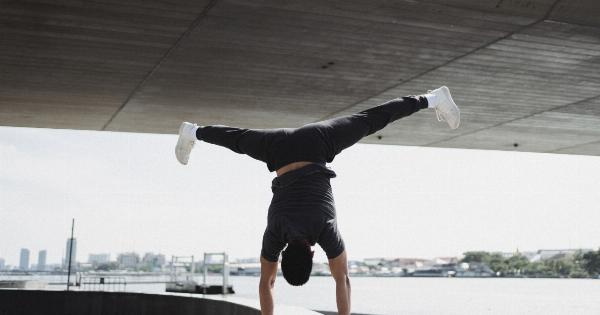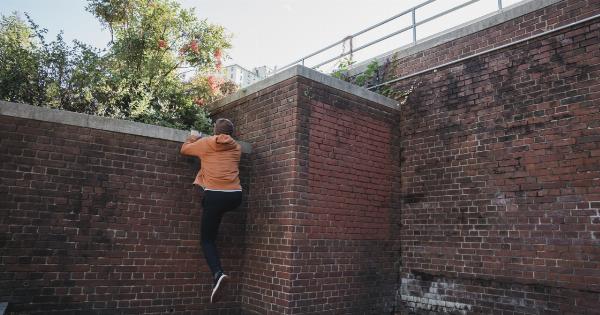Sitting down may seem like a simple task, but it can sometimes lead to discomfort and even pain, especially if you have a weak or injured back.
The way you sit and the posture you maintain during your seated activities can greatly impact your spinal health. To prevent back pain and promote a strong and healthy back, it is essential to practice proper sitting techniques and engage in exercises that target your back muscles.
In this article, we will explore 30 exercises that can help you sit down without hurting your back.
1. Seated Spinal Twist
This exercise helps to stretch and mobilize your spine, promoting flexibility and relieving tension. Sit on a chair with your feet flat on the floor and your back straight.
Place your right hand on the outside of your left thigh and gently twist your torso to the left. Hold for 30 seconds and repeat on the opposite side.
2. Cat-Camel Stretch
This exercise improves the flexibility and mobility of your spine, reducing stiffness and back pain. Start by sitting on a chair with your feet flat on the floor.
Place your hands on your knees and round your back like a cat, bringing your chin toward your chest. Hold for a few seconds, then arch your back and look upward like a camel. Repeat this sequence for 10 repetitions.
3. Pelvic Tilt
The pelvic tilt exercise strengthens the muscles in your lower back and abdomen, improving your posture and reducing strain on your spine. Sit on a chair with your feet flat on the floor and your back straight.
Gently tilt your pelvis forward, flattening your lower back against the chair. Hold for a few seconds, release, and repeat 10 times.
4. Seated Row
This exercise targets the muscles in your upper back, improving posture and reducing the risk of back pain. Sit on the edge of a chair, bend forward slightly, and hold onto the chair’s legs.
Keep your back straight and slowly pull your elbows back, squeezing your shoulder blades together. Hold for a few seconds, release, and repeat for 10 repetitions.
5. Thoracic Extension Exercise
This exercise promotes mobility in your upper back, relieving tension and improving posture. Sit on a chair with your feet flat on the floor and your back straight. Interlace your fingers behind your head and gently lean back, extending your upper back.
Hold for a few seconds, release, and repeat 10 times.
6. Chest Opener
The chest opener exercise helps counteract the forward hunching posture, stretching the chest muscles and improving upper back mobility. Sit on a chair with your feet flat on the floor.
Place your hands behind your head with your elbows pointing out to the sides. Slowly squeeze your shoulder blades together while leaning your head back slightly. Hold for a few seconds, release, and repeat for 10 repetitions.
7. Quads and Hip Flexors Stretch
Tight quads and hip flexors can contribute to lower back pain. Sit on the edge of a chair and place your right ankle on top of your left knee.
Gently press down on your right knee with your hand until you feel a stretch in the front of your right hip and thigh. Hold for 30 seconds and repeat on the opposite side.
8. Glute Bridge
This exercise strengthens your glute muscles, which can help support your lower back and improve your sitting posture. Sit on the edge of a chair with your feet flat on the floor and your hands resting on the chair next to your hips.
Lift your hips off the chair, squeezing your glutes, and hold for a few seconds before lowering back down. Repeat for 10 repetitions.
9. Bird Dog Exercise
The bird dog exercise targets your core muscles, including your back muscles, promoting stability and preventing lower back pain. Start on your hands and knees with your hands directly beneath your shoulders and your knees directly beneath your hips.
Extend your right arm forward while simultaneously extending your left leg backward. Hold for a few seconds, return to the starting position, and repeat on the opposite side. Complete 10 repetitions on each side.
10. Chin Tuck
The chin tuck exercise helps correct forward head posture, reducing strain on your neck and upper back. Sit on a chair with your feet flat on the floor and your back straight.
Gently retract your chin, bringing it back and slightly downward, as if making a double chin. Hold for a few seconds and repeat for 10 repetitions.
11. Shoulder Rolls
A simple exercise to relieve tension and improve shoulder mobility. Sit up straight in your chair and roll your shoulders forward in a circular motion. Repeat for 10 rolls and then reverse the direction for another 10 rolls.
Focus on keeping your movements smooth and controlled.
12. Hip Rotations
This exercise helps improve mobility in the hips and lower back, reducing the risk of lower back pain. Sit on a chair with your feet flat on the floor. Place your hands on your hips and slowly rotate your hips clockwise.
Complete 10 rotations and then repeat in the counterclockwise direction.
13. Standing Forward Bend
A standing forward bend stretch can help with lower back pain and release tension in your back muscles. Stand up straight with your feet hip-width apart.
Slowly bend forward at the hips, reaching towards the ground or your ankles while keeping your legs straight. Hold for 30 seconds and slowly come back up to a standing position.
14. Hamstring Stretch
Your hamstrings can contribute to lower back pain if they are tight. Sit on the edge of a chair and extend your right leg straight out in front of you. Flex your foot and reach forward, attempting to touch your toes.
Hold the stretch for 30 seconds and repeat on the opposite side.
15. Arm Raises
This exercise strengthens your upper back muscles, promoting better posture and reducing strain on your lower back. Sit up straight with your feet flat on the floor and your arms by your sides.
Slowly raise your arms out to the sides until they are parallel to the floor. Hold for a few seconds, lower your arms, and repeat for 10 repetitions.
16. Chair Squats
Chair squats help strengthen your leg and core muscles while improving your ability to sit down and stand up without strain. Stand in front of a chair with your feet hip-width apart.
Lower your body down towards the chair as if you are about to sit down, but hover a few inches above the seat. Hold for a few seconds, then return to a standing position. Repeat for 10 repetitions.
17. Seated Leg Extensions
This exercise targets your quadriceps muscles, improving leg strength and promoting proper sitting posture. Sit on a chair with your feet flat on the floor and your back straight. Extend your right leg straight out in front of you, foot flexed.
Hold for a few seconds and then lower your leg. Repeat with the left leg and complete 10 reps on each side.
18. Side Bends
Side bends engage your oblique muscles, which contribute to overall core stability and help maintain proper spinal alignment. Sit on a chair with your feet flat on the floor and your back straight.
Place your right hand on your right hip and extend your left arm overhead. Gently lean to the right, feeling a stretch along your left side. Hold for a few seconds, return to the starting position, and repeat on the opposite side.
19. Calf Raises
Strong calves can provide better overall support for your lower back. Stand behind a chair with your feet hip-width apart and your hands resting on the back of the chair for support.
Rise up onto the balls of your feet, lifting your heels off the ground as high as you can. Hold for a few seconds, lower your heels back down, and repeat for 10 repetitions.
20. Neck Stretch
Stretching your neck muscles can help alleviate tension and reduce the risk of neck and upper back pain. Sit up straight with your feet flat on the floor. Gently lean your head to the right, bringing your right ear towards your right shoulder.
Hold for a few seconds and then repeat on the left side. Complete 10 repetitions on each side.
21. The Standing Desk Option
If you spend significant time sitting, consider using a standing desk. Standing while working or studying can help reduce back pain and improve posture. It also encourages more movement and helps burn additional calories throughout the day.
22. Back Support
Invest in a chair with good lumbar support or use a lumbar roll to provide extra support for the natural curve of your lower back. This helps maintain correct posture and reduces strain on your back muscles.
23. Take Frequent Breaks
Avoid sitting for extended periods without breaks. Stand up, walk around, and stretch every 30 minutes to alleviate any tension building up in your back muscles.
24. Maintain Good Posture
Practice proper sitting posture by keeping your feet flat on the floor, your back straight, and your shoulders relaxed. Avoid slouching or leaning forward, as this can strain your back muscles and lead to pain.
25. Core Strengthening
Engage in regular core-strengthening exercises such as planks, bridges, and abdominal crunches. A strong core provides stability to your spine and helps maintain proper posture while sitting.
26. Stay Active
Incorporate regular physical activity into your routine, such as walking, swimming, or yoga. Exercise helps keep your back muscles strong and flexible, reducing the risk of pain and injury.
27. Stretch Your Entire Body
In addition to targeted back stretches, make sure to stretch other areas of your body, such as your hips, hamstrings, and chest. This allows for better overall posture and reduces strain on your back.
28. Stay Hydrated
Drinking an adequate amount of water throughout the day helps keep your muscles and joints hydrated. Dehydration can contribute to muscle tension and stiffness, leading to back pain.
29. Manage Stress
Stress and tension can manifest in your back muscles, leading to pain and discomfort. Practice stress management techniques such as deep breathing, meditation, or engaging in hobbies that help you relax.
30. Listen to Your Body
Pay attention to any discomfort or pain you experience while sitting. If a certain position or activity exacerbates your back pain, adjust accordingly or seek professional help.





















